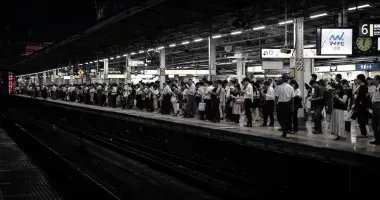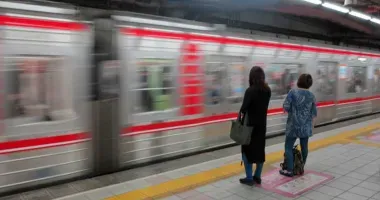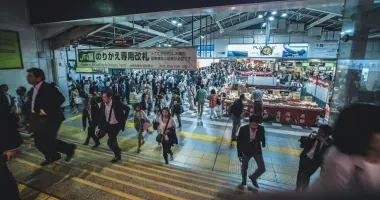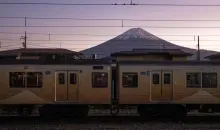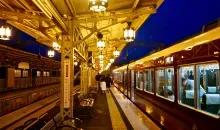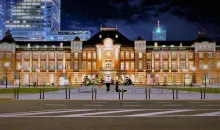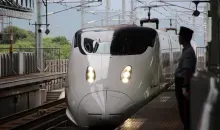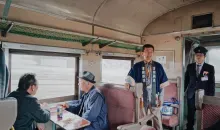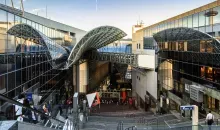Chuo-Sobu Line
Chuo-Sobu Line: the Chuo-Sobu Line is a main east-west rail link in central Tokyo between Mitaka and Chiba.
The JR Chuo Main Line runs west from Tokyo Station all the way to Nagoya, and the JR Sobu Main Line runs east from Tokyo Station all the way to Choshi in Chiba Prefecture. Put together, they form an east-west commuter railway artery through the metropolis.However, there is a section of track, spanning five stations, north of Tokyo Station where neither the Chuo Line nor the Sobu Line run.
The JR Chuo-Sobu Line therefore spans the Chuo and Sobu lines for this stretch of five stations through which neither runs. Furthermore, between Mitaka in the west and Chiba in the east, the Chuo-Sobu line provides a rapid and local service for stations on these lines. The orange Chuo Line (Rapid) acts as the rapid service, and the yellow Sobu Line as the local service.
Train Information
The trains that run on the Chuo-Sobu Line are differentiated by color: yellow is local and referred to as "Sobu Line," and orange is Rapid and referred to as "Chuo Line."
The Chuo-Sobu line's official name is Chuo-Sobu Kanko Sen, "slow-moving Chuo-Sobu line." That's because it provides stations on those two lines with a local (every-station) service in the form of the yellow (Sobu) line, while the orange (Chuo) line provides the express service.
The Chuo Main Line and the Sobu Main Line are "Rapid" (Kaisoku) lines for the length of the Chuo-Sobu Line, i.e., between Mitaka in the west and Chiba in the east. Past where the Chuo-Sobu Line stops, they change back to being "slow" (local) lines.
Chuo-Sobu Line Stations
Chiba | Nishi-Chiba | Inage | Shin-kemigawa | Makuhari | Makuhari-hongo | Tsudanuma |
Higashi-Funabashi | Funabashi | Nishi-Funabashi | Shimosa-Nakayama |
Moto-Yawata | Ichikawa | Koiwa | Shin-Koiw | Hirai | Kameido |
Kinshicho | Ryogoku | Asakusabashi | Akihabara | Ochanomizu | Suidobashi | Iidabashi | Ichigaya
| Yotsuya | Shinanomachi | Sendagaya | Yoyogi | Shinjuku | Okubo | Higashi-Nakano | Nakano | Koenji |
Asagaya | Ogikubo | Nishi-Ogikubo | Kichijoji | Mitaka






Notable Stations
Kinshicho 錦糸町
Kinshicho is a large, lively commercial center and with the large Sumida Triphony Hall, and only a 20 minute walk from Tokyo SkyTree in the north. Sarue-onshi Park is one stop south (Sumiyoshi Station) on the Tokyo Metro Hanzomon Line. Change at Sumiyoshi Station for the Toei Shinjuku Subway Line.
Sobu Rapid (kaisoku) and Commuter Rapid (tsuukin kaisoku) trains also stop at Kinshicho. Transfer here for the Tokyo Metro Hanzomon Line.
Ochanomizu 御茶ノ水
Ochanomizu Station is in Ochanomizu, a university district that also has some elegant religious buildings such as the imposing Yushima Seido, Yushima Tenjin Shrine, as well as the beautiful Kyu-Iwasaki Tei Garden.
The Rapid (kaisoku), Commuter Rapid (tsuukin kaisoku), Chuo Special Rapid (Chuo tokkai), Ome Special Rapid (Ohme tokkai), Commuter Special Rapid (tsuukin tokkai), the Chuo Liner (Chuo lainaa) and Ome Liner (Ome lainaa) also stop at Ochanomizu.
Change at Ochanomizu Station for the Tokyo Metro Chiyoda Subway Line (Shin-Ochanomizu Station - take the Hijiribashi Exit from Ochanomizu Station), the Tokyo Metro Marunouchi Subway Line (take the Ochanomizu-bashi Exit, then cross the bridge).
Shinjuku 新宿
Shinjuku Station is the biggest station on the Chuo-Sobu Line.
The Rapid (kaisoku), Commuter Rapid (tsuukin kaisoku), Chuo Special Rapid (Chuo tokkai), Ome Special Rapid (Ohme tokkai), Commuter Special Rapid (tsuukin tokkai), the Chuo Liner (Chuo lainaa) and Ome Liner (Ome lainaa) also stop at Shinjuku.
Transfer at Shinjuku to the Yamanote Line, the Saikyo Line, the Shonan Shinjuku Line, the Narita Express, the Odakyu Odawara Line, the Keio Line, the Keio New Line, and the Seibu Shinjuku Line. Underground passages facilitate transferring to the following nearby stations: Shinjuku San-chome Station on the Tokyo Metro Fukutoshin Subway Line and the Tokyo Toei Shinjuku Subway Line, Nishi-Shinjuku Station on the Tokyo Metro Marunouchi Subway Line, Shinjuku Nishi-guchi Station on the Tokyo Toei Oedo Subway Line, Tocho-mae Station on the Tokyo Toei Oedo Subway Line.






